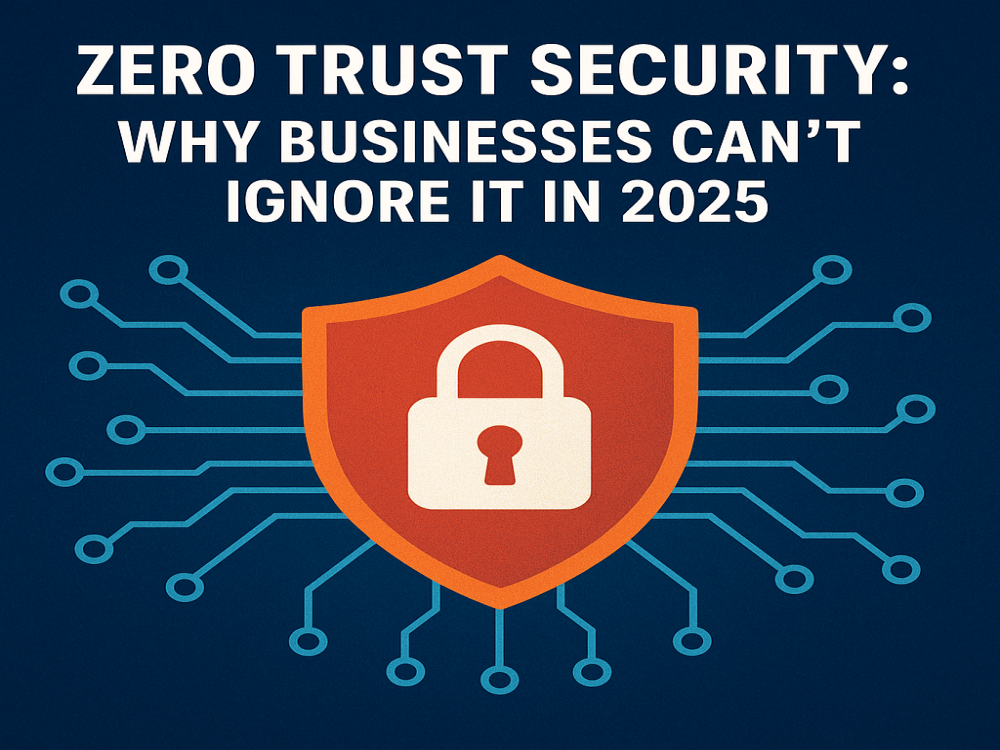
Recent Blogs
In an era where cyber threats evolve at an unprecedented pace, traditional security models are increasingly inadequate. The rise of remote work, cloud computing, and sophisticated AI-driven attacks has dissolved the once-reliable network perimeter, exposing businesses to new vulnerabilities. Enter Zero Trust Security—a paradigm that redefines cybersecurity by assuming no user, device, or connection is inherently trustworthy. As we move into 2025, Zero Trust is no longer a forward-thinking option but a critical necessity for businesses aiming to protect their assets, maintain customer trust, and comply with stringent regulations. This article explores the importance of Zero Trust Security, its core principles, and actionable steps for businesses to adopt it effectively.
The Evolving Threat Landscape in 2025
The cybersecurity landscape in 2025 is more complex than ever. According to industry insights, cyberattacks occur every 39 seconds, with breaches costing organizations an average of over $3 million per incident. The proliferation of hybrid work models, multi-cloud environments, and Internet of Things (IoT) devices has expanded attack surfaces exponentially. Meanwhile, AI-powered threats, such as deepfake phishing and automated malware, are growing in sophistication, bypassing legacy defenses like firewalls and VPNs. High-profile breaches targeting critical infrastructure and sensitive data further underscore the limitations of perimeter-based security, which assumes internal users are safe.
Zero Trust Security addresses these challenges by operating on the principle of "never trust, always verify." Unlike traditional models that rely on a fortified perimeter, Zero Trust assumes breaches are inevitable and enforces continuous validation of every user, device, and transaction, regardless of their location. This approach is becoming the default for enterprises, with Gartner predicting that by 2025, 60% of organizations will adopt Zero Trust as their foundational security strategy, a significant rise from previous years.
Core Principles of Zero Trust Security
Zero Trust is not a single product but a strategic framework built on three foundational principles, as outlined by the NIST 800-207 standard:
Continuous Verification: Every access request—whether from an employee, contractor, or device—must be authenticated and authorized using all available data points, such as identity, device health, and behavior. This eliminates implicit trust and ensures real-time risk assessments.
Least Privilege Access: Users and devices are granted only the minimum access necessary to perform their tasks. This reduces the attack surface by limiting lateral movement within networks, even if a breach occurs.
Assume Breach: Zero Trust operates under the assumption that the network is already compromised. By implementing micro-segmentation, end-to-end encryption, and robust monitoring, businesses can minimize the impact of breaches and contain threats swiftly.
These principles shift security from a location-centric to a data-centric model, ensuring granular control and visibility across distributed environments. By integrating tools like multi-factor authentication (MFA), identity and access management (IAM), and endpoint detection and response (EDR), Zero Trust creates a resilient defense against modern threats.
Why Zero Trust Is Non-Negotiable in 2025
Adopting Zero Trust Security offers compelling benefits that align with business priorities in 2025. Here’s why it’s indispensable:
Reduced Breach Costs: Organizations with mature Zero Trust implementations experience data breach costs approximately $1 million lower than those without, mitigating financial impacts like regulatory fines, legal fees, and reputational damage. This is critical as breaches increasingly target sensitive customer data and intellectual property.
Enhanced Regulatory Compliance: With regulations like GDPR, HIPAA, and CCPA tightening, Zero Trust aligns seamlessly with compliance requirements by enforcing strict access controls, data encryption, and audit trails. Government mandates, such as the U.S. Executive Order 14028, further emphasize Zero Trust for federal agencies, setting a precedent for private sectors.
Support for Modern Work Environments: The shift to hybrid work and cloud adoption has rendered traditional VPNs obsolete. Zero Trust Network Access (ZTNA) solutions provide secure, scalable access for remote users and cloud applications, ensuring seamless productivity without compromising security.
Protection Against AI-Driven Threats: As cybercriminals leverage AI for advanced attacks, Zero Trust counters with AI-powered analytics for real-time threat detection, behavioral analysis, and automated policy enforcement. This keeps businesses ahead of evolving risks.
Customer Trust and Competitive Advantage: By prioritizing robust security, businesses build trust with customers who demand ironclad data protection. Zero Trust not only prevents breaches but also signals a commitment to privacy, enhancing brand loyalty and market positioning.
Despite these benefits, adoption challenges persist. A Gartner survey notes that 35% of organizations attempting Zero Trust faced operational disruptions due to poor strategic alignment or execution. Overcoming these hurdles requires a deliberate, phased approach.
Implementing Zero Trust: A Practical Roadmap for 2025
Transitioning to Zero Trust is a journey, not a one-time project. Businesses can adopt it effectively by following these steps:
Define Business and Security Objectives: Identify critical assets—such as sensitive data, proprietary applications, or customer records—and prioritize their protection. Mapping user workflows to these "protection surfaces" ensures focused risk mitigation.
Secure Identity and Access: Implement MFA, single sign-on (SSO), and risk-based adaptive access controls to verify identities continuously. Passwordless authentication, using biometrics or passkeys, enhances both security and user experience.
Enforce Micro-Segmentation: Divide networks into isolated zones to limit lateral movement by attackers. Studies show micro-segmentation can reduce breach costs by up to 50% by containing threats within smaller segments.
Leverage AI and Analytics: Deploy AI-driven tools for anomaly detection, predictive risk analysis, and automated threat response. Integrating these with Security Operations Centers (SOCs) enhances real-time visibility.
Integrate with Existing Infrastructure: Choose Zero Trust solutions compatible with current identity providers, endpoint protection tools, and cloud platforms to avoid silos and ensure scalability. Vendors like Microsoft, CrowdStrike, and Zscaler offer robust integrations.
Foster a Security-First Culture: Educate stakeholders across IT, business units, and leadership on Zero Trust principles. A steering committee with C-level representation aligns security with business goals, ensuring buy-in and accountability.
Monitor and Iterate: Conduct regular audits, penetration tests, and red team exercises to refine policies. Continuous monitoring and user behavior analytics (UEBA) detect anomalies early, enabling rapid response.
Starting with high-value assets and scaling incrementally minimizes disruption while building momentum. Partnering with experienced vendors can streamline implementation, as seen with solutions like Zscaler’s Zero Trust Exchange, adopted by 40% of Fortune 500 companies.
Looking Ahead: Zero Trust as a Business Imperative
As we forge deeper into 2025, Zero Trust is transitioning from a strategic advantage to a baseline requirement. The global Zero Trust market is projected to reach $86.57 billion by 2030, reflecting its growing adoption across industries. However, success hinges on more than technology—it demands strategic alignment, robust governance, and a cultural shift toward proactive security.
Businesses that ignore Zero Trust risk not only financial losses but also erosion of customer trust and regulatory penalties. Conversely, those that embrace it will fortify their defenses, streamline operations, and position themselves as trusted leaders in a digital-first world. The time to act is now: assess your organization’s Zero Trust maturity, align with industry standards like NIST 800-207, and take the first step toward a secure future. For tailored guidance, explore resources from trusted providers or consult with cybersecurity experts to craft a roadmap that fits your unique needs.

Sarfraj
Senior Developer
Comments 0
No comments yet.

